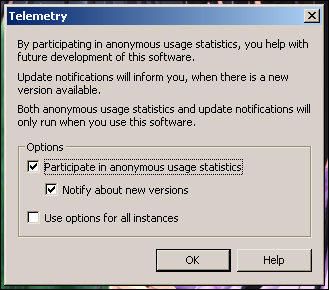Telemetry
 Anonymous Usage Statistics tracks how and how often you use an application. Update notifications inform you whenever there is new version available for the application you are using. The following gives more details on how this affects you and your application usage.
Anonymous Usage Statistics tracks how and how often you use an application. Update notifications inform you whenever there is new version available for the application you are using. The following gives more details on how this affects you and your application usage.
Anonymous Usage Statistics
To aid future development, some applications may track how often you use them, in what environment and in some applications also how you use them. The exact data disclosed by an application is always part of the documentation, so make sure to check the included privacy.txt. Now the question may be, what use it is for future development.
The primary metric, the usage count, which is usually measured in usages per week and users per week, directly affects how much love (maintenance) the application receives. An application that has less than a hand-full of users is generally not worth maintaining and will receive little to no attention.
The main environmental metrics are the OS version and hardware platform1. Together with other metrics, this allows determining:
- which OS/platform is always included in the release QA testing process (the most popular ones)
- which OS/platform might be impacted by a breaking change2
- which OS/platform is affected by issues reported by other metrics
Anonymous usage statistics are collected only during the use of the application; as soon as you stop using the application, the metric collection also stops. Metrics are collected only from the data the application generates itself, no other data is involved. Most telemetry data is public in aggregated form, available for up to five weeks, after which it is discarded. The running week stores user-identifiable data (IP address) to collect user counts; this user-identifiable data is not used to further identify the particular user, only to discriminate them, and is discarded after one week. If you need help with a specific problem, report it, the anonymous usage statistics will not do that for you.
In the UI, this is controlled by the Participate in anonymous usage statistics setting.
Update Notifications
When you turn on update notifications, the application will inform you in regular intervals (typically a week), if there is a new version for that application available. The application may also include information about changes that the new version will include. Checks for new updates occur only when you actively3 use the application. Update notifications may include support for emergency messages4, that may ignore your settings and show a message regardless.
Because checking for new versions discloses some telemetry information, you have to accept anonymous usage statistics, if you want notifications of new versions.
In the UI, this is controlled by the Notify about new versions setting.
Global Setting
Portable applications5 may come in several versions or flavors6 on a single computer. Each and every such instance will ask you for separate approval, which may be tedious. For this reason, when you approve (or decline) anonymous usage statistics and update settings, you can save these globally7 for all current and future instances of this software. By default, the global settings override the local settings of each instance, but you are given the option to delete the global settings when you try to store the settings locally. Other software will still ask you for separate approval.
In the UI, this is controlled by the Use options for all instances setting. In some software this setting is disabled.
Foot notes
- Most prominently the Intel®©™ 32-bit and 64-bit CPU instruction sets and virtualizations thereof.
- For example when its usage count drops to zero or suddenly exhibits high usage count.
- Applications, that run in auto-pilot modes (for example
/updateonlyin RO Patcher Lite) do not check for new versions. - This is the sort of notifications, that you never should or want to see, because they imply some very serious issue. Applications with very large user bases (millions) may be required to distribute emergency broadcasts issued by the local government in some jurisdictions.
- Applications that do not use an installation, but run out of the box and use an
.inifile (or other local file based storage) to store settings. - For example the jRO and kRO configurations of RO Patcher Lite are flavors of the same application.
- The settings are saved as part of the roaming user profile application data. So each user can have their own preferences.